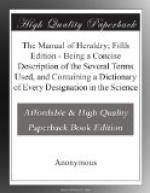[Illustration: Clenched]
Ex. Azure, a dexter arm vambraced couped, the fist clenched proper.
CLOSE. A bird with its wings closed.
[Illustration: Close]
CLOSET. A diminutive of the bar, being only one half its width.
[Illustration: Closet]
Ex. Or, two closets azure.
CLOSEGIRT. A figure whose dress is fastened round the waist.
[Illustration: Closegirt]
Ex. Gules, an angel erect with wings expanded or, dress closegirt.
COAT ARMOUR, or Surcoat. A loose garment worn over the armour of a knight; hence the term coat of arms. On this garment were emblazoned the armorial bearings of the wearer.
[Illustration: Coat Armour]
COCKATRICE. A chimerical animal, a cock with a dragon’s tail and wings.
[Illustration: Cockatrice]
COLLARED. Having a collar. Dogs and inferior animals are sometimes collared: the supporters and charges are generally said to be gorged. See GORGED.
COMBATANT. A French word for fighting. See LION.
COMPLEMENT. The Heraldic term for the full moon. When this figure is introduced as a charge in a coat of arms, it is called a moon in her complement.
COMPONY. A term applied to a bordure, pale, bend, or any other ordinary, made up of squares of alternate metal and colour.
[Illustration: Compony]
Ex. Argent, an inescutcheon azure, border compony, or and gules.
CONJOINED. Joined together.
[Illustration: Conjoined]
Ex. Argent, three legs armed, conjoined at the fess point at the upper extremity of the thigh, flexed in a triangle, garnished and spurred, or.
CONY. An heraldic name for a young rabbit.
[Illustration: Cony]
COTICE. One of the diminutives of the bend: cotices are generally borne on each side of the bend.
[Illustration: Cotice]
Ex. Gules, a bend argent, coticed of the same.
The cotices are frequently of a different tincture from the bend they cotice.
COUCHANT. The French word for lying down with the breast towards the earth, and the head raised. See LION COUCHANT.
COUNT. A nobleman that was deputed by the king to govern a county or shire: the title is not used in the British Peerage; his rank is equal to an earl.
COUNTER. In Heraldry implies contrariety, as in the following examples:—
COUNTER-CHANGED. The intermixture of metal with colours opposed to each other.
[Illustration: Counter-changed]
Ex. Per pale, or and azure, on a chevron, three mullets all counter-changed.
COUNTER SALIENT. Two animals leaping different ways from each other.
[Illustration: Counter salient]
Ex. Argent, two foxes counter salient.
COUNTER PASSANT. Two animals passing the contrary way to each other.




